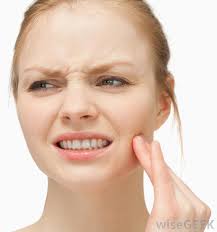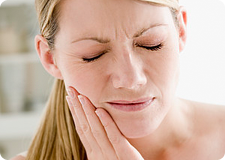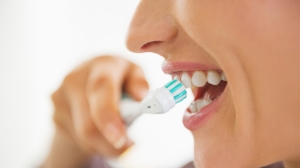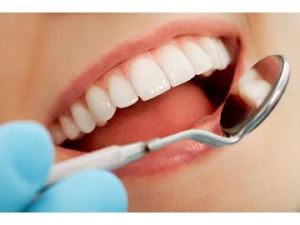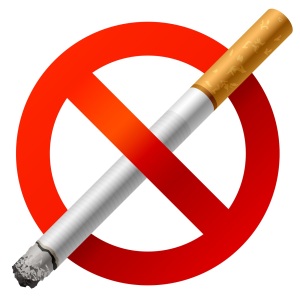More than 15 percent of adults suffer from some chronic facial pain, such as jaw tenderness, jaw popping, headaches, and neck aches. Grinding or clenching the jaw is the most common cause, although TMJ can also occur because of arthritis of the jaw joint or trauma to the head, such as the blow from an airbag during a car accident. Grinding can also increase your risk for other dental problems, such as gum disease, tooth erosion, and cracked teeth. If you suspect that you’re grinding or clenching your teeth, talk to your dentist. They may prescribe a custom mouth guard, or splint, to reduce the pressure on your teeth and jaw. Stress-reducing techniques such as meditation can also help you cut down on the grinding that leads to TMJ. Also, try applying a warm, wet washcloth to the jaw to relax the muscles.
NEW STUDY EXAMINES POPULATION-WIDE #ORALHEALTH DYNAMICS (via @therabreath)
31 MarAccording American Academy of Pediatric Dentistry, tooth decay is the most common chronic disease among children. The source notes that while efforts to improve oral health care are not currently aligned with Triple Aim – a wide ranging plan to improve health care – new research could help policymakers decide on the best course of action to take for reducing childhood caries. However, a recent study published in the Journal of the American Dental Association provided a thorough analysis of nine different approaches to better public oral health.
What is Triple Aim?
Triple Aim is a framework developed by the Institute for Healthcare Improvement that gets its name from three main tenets: improving the health of general populations, reducing the cost of health care per capita and improving the quality and experience of health care worldwide. IHI believes the Triple Aim approach can ensure better health outcomes for Americans and strengthen the nation’s health care system overall.
How does Triple Aim relate to tooth decay?
It’s common knowledge among industry experts that early childhood caries are generally preventable, but tooth decay occurs prevalently at a young age due to a lack of dental care. One reason for this problem is the cost of care, which falls within the scope of the Triple Aim. If dental care becomes more affordable per capita, then ideally many children will receive the dental care they need. Measures taken on a population-wide scale can provide major benefits to general health, but finding the most effective solutions on a systemic level can be complicated.
With this information, scientists tested nine different system dynamics: water fluoridation, fluoride varnish, fluoride toothpaste, medical screening and fluoride varnish application, bacterial transmission reduction, motivational interviewing, dental prevention visits, secondary prevention and combinations. These dynamics were implemented to populations of young children in the New York State Medicaid system, as treating childhood caries takes up a significant portion of Medicaid dollars.
Finding the optimal method for preventing childhood caries could not only potentially save money, but more importantly, lead to better long-term outcomes for young children. Though the study could not definitively identify one dynamic for providing the best prevention strategy, scientists were able to conclude that implementing specific dynamics in populations could reduce state costs and contribute to better public health. Therefore, these dynamics could benefit the goals of Triple Aim holistically.
Source: http://www.therabreath.com/articles/news/oral-care-industry-news/new-study-examines-population-wide-oral-health-dynamics-36285.asp
Daily Dental Tip: Drink Water with Acidic Beverages
30 MarMany people like to enjoy energy drinks or coffee to wake up in the morning. The problem with these drinks is that they are very acidic, and acid can wear down the enamel (the protective outer coating on your teeth), making teeth more prone to decay, sensitivity and infection. The easy answer: drink a sip of water here and there when drinking such beverages; the water will help to neutralize the acids and prevent enamel erosion.
#Oralhealth of special needs #children prompts hygienist to develop school-based program (Via @DentistryIQ)
30 MarOn one typical day in the dental office — amidst the sounds of ringing phones, talking people, and the printing of appointment slips — I overheard a woman at the front desk ask about a toothbrush for a special needs child. Her request immediately caught my attention because it was for a special needs child and because “toothbrush” is a key word in the love language of dental hygienists.
Upon hearing the conversation, I learned she had received a “different kind of toothbrush” from an orthodontist many years earlier. She proceeded to say, “I’ve been everywhere looking for this toothbrush, and no one seems to carry it. Can you help me?”
I found out that she worked as a teacher in a local public school’s severe and profound multiple disabilities class, which consisted of children with Down syndrome, cerebral palsy, intellectual disabilities, hearing loss, visual impairments, and seizures. Upon building rapport, I learned of the significant need to raise awareness about the many barriers that impact access to care for special needs children, as well as of the need for those barriers to be overcome. I decided to find out whether I could help to educate teachers and caregivers of special needs children about oral hygiene instruction and practices.
Many factors contribute to poor oral health problems for children with disabilities. Research has proved that over 80 craniofacial syndromes can negatively affect oral cavity development in children with special needs.(1) Limitations in performing daily oral health-care practices, such as brushing and flossing, can be challenging for both the individual and the caregiver.
Medications, malocclusion, developmental defects, poor physical coordination, and lack of appropriate knowledge about maintaining oral health can all increase the prevalence of dental diseases in disabled children.(2) Not to mention, numerous dental needs among special needs children are unmet due to limited funding for preventive programs and the resulting lack of treatment delivery.
A difference-maker continually searches and finds ways to overcome given situations.
Setting up school-based program
In order to visit the school, I needed to collaborate with parents, legal caregivers, and the public school system. After making many phone calls, doing a lot of paperwork, and acquiring the appropriate authorization, I was able to educate teaching staff and caregivers at the school about periodontal disease and oral hygiene instruction and practices.
In my program, I used “An Oral Health Professional’s Guide to Serving Young Children with Special Health Care Needs” as a visual guide for aiding in detection of dental diseases.(2) Throughout the day, oral hygiene methods were practiced twice but only with limited resources. Upon observation, I discovered that specialized prevention aids and instructions about plaque removal were needed. While teaching modified brushing techniques in the first class, I learned that over 90% percent of the children had active decay and/or moderate to severe dental disease(s) that needed immediate attention. Upon arriving in the next classroom, I found the exact same results. Improving the oral hygiene education of teachers and caregivers was a start to helping to eliminate the disparity, but stopping there was not an option.
The goal was set small, but the bar was raised high when the need became so great. To me, making a difference for those children meant looking for ways to help eliminate the financial barriers that may have prevented them from getting necessary treatment and/or products.
So my next step was to look for possible donations, but resources were limited — until a grant from a local medical and dental health board funded the purchase of preventive products for oral health care. The grant gave me the opportunity to reach more special needs children within the school setting.
After I received the funds for the prevention aids, an individualized conducive assessment was created and conducted.
Disposable mirrors, gloves, masks, and gauze were donated. In addition, the following prevention items were purchased: fluoride varnish, toothbrushes, floss, floss holders, antimicrobial toothpaste, disclosing solution, Q-tips for applying the disclosing solution, bite blocks, additional antimicrobials, extra-grip toothbrush holders, various modified toothbrushes, Spry Rain mouth spray, mouthguards, and mouth props.
The assessments included reviewing students’ health histories and medications prior to their dental screenings and determining whether they had any malocclusion or teeth with developmental defects. Reduced physical coordination, oral habits, and behavioral limitations were also taken into account. Finding out what made the children smile or what they preferred was the fun part in seeing what was needed.
The initial assessment and the specialized products took plaque control to a whole new level. We had floss, floss aids, appropriate-sized manual toothbrushes, Benedent Corporation’s three-prong toothbrushes, and powered Oral-B or Sonicare toothbrushes.
I encouraged the teachers and caregivers to use disclosing solution continuously to aid in the identification of plaque. Antimicrobial Colgate toothpaste was used for removal. I stressed the benefits of using xylitol and provided each child with Spry Rain mouth spray to aid in decreasing oral bacteria. Three to four fluoride varnish treatments were applied at three-month intervals to aid in decreasing the high risk for dental caries. Nutritional counseling and additional oral hygiene instruction were also provided. Additional adjunctive items, such as antimicrobial mouth rinse, mouth props, and mouthguards were also distributed as was appropriate to the obstacles unique to each child.
Parents were notified via phone calls if treatment was urgent, and letters were sent home for reviewing. Specialized dental professionals were contacted for referrals, and appointments were made.
Read More: http://www.dentistryiq.com/articles/2015/03/it-makes-a-difference-to-me-the-oral-health-of-special-neeeds-children-prompts-hygienist-to-develop-school-based-program.html
Daily Dental Tip: How To Avoid Cavities
27 MarIn addition to keeping your mouth clean with regular brushing and flossing, ask your dentist about sealants or fluoride treatments. If you’re prone to cavities, these measures can help prevent more decay from occurring. In addition, you should reduce your consumption of sugar, especially carbonated sodas, which also contain enamel-harming acid.
Daily Dental Tip: Prevent Gum Disease Naturally
26 MarAccording to the American Academy of Periodontology (AAP), up to 30 percent of people are generally susceptible to gum disease. Maintaining good oral hygiene is the best thing you can do to stop this. To prevent gum disease, floss once a day and brush twice a day using toothpaste and a soft-bristled toothbrush. Toothbrush options include manual toothbrushes, and for extra brushing strength, power brushes. You can also rinse daily with an antiseptic mouthwash.
Oral health and your diet (via @InsideHalton)
26 MarWe hear about maintaining good oral hygiene through proper brushing and flossing, but Dr. Branko Radisic Dental, with offices in Milton and Mississauga, poses something that few of us ever consider: how a good diet can be important to good oral health.
Our food choices can be as important to our oral health as how we care for our teeth. The mouth, teeth, and gums are on the forefront of the digestive process. When the quality of our food choices suffers, the effects of that poor diet tend to show first in the teeth and gums.
An agency for the U.S. Department of Agriculture, called the Center for Nutrition Policy and Promotion recommends the following for a healthy diet:
Fruits and vegetables – all together, these should cover half your plate at meals;
Grains – no less than half the grains you consume should be whole grains, examples are oatmeal, whole wheat, and brown rice;
Diary – go with low-fat or fat-free dairy foods;
Protein – Lean protein choices are best, such as lean beef, skinless poultry, and fish. Vary this to include eggs, beans, peas, and legumes. As well, try to consume eight ounces of seafood each week.
For purposes of dental health, snacking should (ideally) be limited between meals. Since this isn’t always realistic, try to avoid common culprits of tooth decay like sweets and chips. Instead, go with nutritious choices like cheese, yogurt, fruits, vegetables, and nuts. These foods will be far better for your overall health as much as your oral health.
As well, here are nine major offenders of gum and dental disease that you should watch out for:
Hard candy – if you eat too much too often, all that exposure to sugar will have a damaging effect to your teeth and gums;
Ice – despite what you may have heard, ice is not good for your teeth. It can damage enamel and lead to dental emergencies;
Citrus and acidic foods – frequent exposure can harm your teeth’s enamel. Also, citrus fruits and juices can irritate mouth sores;
Coffee (and tea) – in their natural form, these can actually be healthy food choices. But problems happen when people “dress up” these beverages, particularly when sugar is involved. Also, tea and coffee can stain your teeth;
Sticky foods – even dried fruits become a problem for your teeth. If you must indulge, brush, floss, and rinse thoroughly afterward;
Potato chips – chips contain starch and tend to get caught between your teeth. Make it a habit to brush and floss after enjoying them;
Sodas (pop) – the majority of carbonated beverages, including diet versions, are acidic, which are bad for your teeth. Caffeinated beverages like colas can dry out your mouth;
Alcohol – any alcohol consumption will cause dehydration and a dry mouth. Heavy alcohol use will increase your risk for mouth cancer;
Sports drinks – although these drinks sound healthy, they are often loaded with sugar. When in doubt, drink water!
Hopefully, this will provide some insight into how the foods we eat can affect our dental health. Along with good habits of brushing and flossing, we can all take steps to ensure the health of our teeth and gums, as well as our overall well-being.
To learn more and to establish a great dental-care program for you and your loved ones, contact Dr. Branko Radisic Dental. The clinic has locations in Milton and Mississauga, and provides extensive services in general dentistry, cosmetic dentistry, orthodontics, and periodontics.
Source: http://www.insidehalton.com/shopping-story/5525191-oral-health-and-your-diet/
Daily Dental Tip: Quit Smoking for Oral Health!
25 MarBesides reducing your risk for gum disease, quitting smoking can help you avoid cavities as well. The tar from cigarettes makes the surface of the teeth sticky, which allows bacteria to cling to your enamel. The heat from smoking also dries out your mouth, which means there’s less saliva to wash away bacteria.
New dental study helps move oral health in positive direction (via @dentistryiq)
25 MarExperts agree that the so-called Triple Aim should guide future reforms in health care — achieving better individual care and population health while reducing per capita costs. Although tooth decay is the most common chronic disease of childhood, efforts to improve dental health are not yet aligned with the Triple Aim. A study in the new issue of the Journal of the American Dental Association (JADA) could help move oral health in this direction by assessing both the impact and cost of nine approaches to preventing Early Childhood Caries (ECC).
To view the entire study click here.
The co-authors used New York State data to project both the costs and decay-reduction impact of certain strategies to prevent tooth decay in the ECC population (children ages 0-5). A 2012 study revealed that ECC-related visits to hospital emergency rooms or ambulatory care centers in New York State averaged 5,124 per year over a five-year period. In the final year of that time, the average cost per visit was $5,501.
Because low-income children are at higher risk for tooth decay, the co-authors assessed the impact and cost of prevention approaches for the Medicaid population. The co-authors used systemic dynamics modeling to project how each prevention strategy would change the extent of ECC and how much each strategy would cost (or save).
Source: http://www.dentistryiq.com/articles/2015/03/new-dental-study-helps-move-oral-health-in-positive-direction-by-supporting-prevention-of-early-childhood-caries.html

